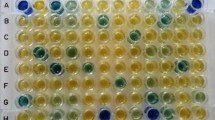Summary
A technique for the accurate estimation of 0.01 ppm of tecnazene in potatoes (recovery factor 91.6% ±2.8) has been developed by gas chromatography after a preliminary clean-up treatment on an alumina column. 1 μg of tecnazene per kg fresh weight of potato can be detected by this method with some loss in accuracy. In laboratory samples treated at commercial rates 2 to 8 mg/kg were found in all potato samples analysed. 0.1 to 1.0 mg/kg were detected in peeled and boiled potatoes. The implications of these results are discussed.
Zusammenfassung
Es wurde eine Technik für die genaue Berechnung von 10 μg. Tecnazen per kg in Kartoffeln (Erfassungsfaktor 91,6%+2,8) entwickelt, indem nach einer Vortrennung über eine Aluminiumsäule Gaschromatographie angewendet wurde.
Beim Extrahieren des Tecnazens aus den ganzen Kartoffeln hielt man es für wesentlich, den ersten Verarbeitungsschritt ausschliesslich mit Aethanol durchzuführen, wenn die Bildung einer stabilen Emulsion vermieden werden sollte. Das Hexan wurde nachträglich beigefügt. Um den obenerwähnten Grad der Genauigkeit zu erreichen, wurden bei allen Gelegenheiten Lösungsmittel guter Qualität benützt, d.h. ‘nanograde’-Hexan.
Die Wirksamkeit der Fraktionierung in der Aluminiumsäule (Abb. 1) hing von der genauen Kontrolle der Durchflussrate und von der Aufrechterhaltung wasserfreier Bedingungen über die ganze Zeit ab. Aliquote der zugehörigen Fraktionen aus der Aluminiumsäule wurden, nach Reduktion des Volumens unter Vakuum, direkt in einem Gaschromatographen angewendet (Abb. 2).
Alle analysierten Kartoffelmuster, sowohl die im Labor behandelten als auch die aus handelsüblichem Lager, enthielten Tecnazen. Die festgestellten Konzentrationen in ganzen gewaschenen Kartoffeln varierten von 2 bis 8 mg/kg Frischgewicht der Knolle und von 0.1 bis 1,0 mg/kg geschälten und gekochten Mustern (Tabelle 1). Die Folgerungen aus diesen Ergebnissen für die Ernährung sowie die Vorzüge und die mögliche Wirkungsart dieses Wirkstoffes als Keimhemmungsmittel und als Fungizid werden kurz diskutiert.
Résumé
Les auteurs ont mis au point une technique de détermination d'une précision de 10 μg du tecnazène 1 kg (facteur de récupération 91,6%+2.8) par chromatographie en phase gazeuse après purification préalable sur une colonne d'alumine.
Lorsqu'on extrait le tecnazène de pommes de terre entières, il est essentiel d'effectuer le mélange initial d'abord en présence d'éthanol seul si l'on veut éviter la formation d'une émulsion stable. L'hexane est ajouté par après. Pour atteindre un degré de sécurité ci-dessus cité, on emploie des solvants de bonne qualité en toutes occasions, par example l'hexane ‘nanograde’.
L'efficacité du fractionnement sur la colonne d'alumine (fig. 1) dépend de la précision du contrôle de la vitesse du flux et du maintien de conditions anhydres. On soumet directement au gaz chromatographique (fig. 2) les aliquotes des fractions appropriées provenant de la colonne d'alumine après réduction du volume sous vide.
On a trouvé du tecnazène dans tous les échantillons de pommes de terre analysés, qu'ils proviennent de traitements en laboratoire ou de stocks commerciaux. Les concentrations trouvées dans les pommes de terre entières lavées varient de 2 à 8 mg/kg poids frais des tubercules et de 0,1 à 1.0 mg/kg échantillons pelés et bouillis (tabeau 1). Les auteurs discutent brièvement des conséquences de ces résultats dans l'alimentation, et ainsi que des mérites et du mode d'action possible de cette matière chimique comme inhibiteur de germination et comme fongicide.
Similar content being viewed by others
References
Auerbäch, M. E., 1950. Colorimetric estimation of tetrachloronitrobenzene.Analyt. Chem. 22: 1287–1288.
Brown, W., 1947. Experiments on the effect of chlorinated nitrobenzenes on the sprouting of potato tubers.Ann. appl. Biol. 34: 422–429.
Brown, W. & M. J. Reavill, 1954. Effect of tetrachloronitrobenzene on the sprouting and cropping of potato tubers.Ann. appl. Biol. 41: 435–447.
Bray, H. G., Z. Hybs, S. P. James & W. K. Thorpe, 1953. The metabolism of 2∶3∶5∶6 and 2∶3∶4∶5-tetrachloronitrobenzenes in the rabbit and the reduction of aromatic nitro compounds in the intestine.Biochem. J. 53: 266–273.
Buttle, G. A. H. & F. J. Dyer, 1950. Experiments on the toxicology of 2∶3∶5∶6-tetrachloronitrobenzene.J. Pharm. Pharmacol. 2: 371–375.
Cänbäch, T. & H. Zajaczkowska, 1950. The photometric determination of 2∶3∶5∶6-tetrachloronitrobenzene.J. Pharm. Pharmacol. 2: 545–548.
Higgons, D. J. & A. Toms, 1957. Colorimetric analysis of the isomers of tetrachloronitrobenzene and evaluation of deposits on the soil obtained from smokes of the 2∶3∶5∶6 isomer (tecnazene).J. Sci. Fd Agric. 8: 309–313.
Reavill, M. J., 1954. Effect of certain chloronitrobenzenes on germination, growth and sporulation of some fungi.Ann. appl. Biol. 41: 448–460.
Sondheimer, E., 1964. Chlorogenic acid and related depsides.Bot. Rev. 30: 667–723.
Vliet, W. F. van & S. Hertog, 1966. The analysis of sprout inhibitor residues in the potato tuber.Eur. Potato J. 9: 152–159.
Webster, J. G. & J. A. Dawson, 1952. A polarographic method for the estimation of tetrachloronitrobenzene residues on potatoes.Analyst 77: 203–205.
Author information
Authors and Affiliations
Rights and permissions
About this article
Cite this article
Dalziel, J., Duncan, H.J. Studies on potato sprout suppressants. 1. Residual levels of tecnazene in laboratory-treated and in commercial samples of potatoes. Potato Res 17, 215–223 (1974). https://doi.org/10.1007/BF02360388
Accepted:
Published:
Issue Date:
DOI: https://doi.org/10.1007/BF02360388




